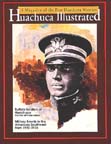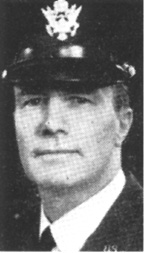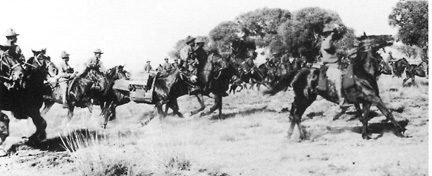 Huachuca
Illustrated, vol 1, 1993:
Huachuca
Illustrated, vol 1, 1993: Huachuca
Illustrated, vol 1, 1993:
Huachuca
Illustrated, vol 1, 1993:
chuca Illustrat
chuca Illustrat
Buffalo Soldiers at Huachuca:
The Battle of Agua Caliente
chuca Illustrat
March 31, 1916 found the 10th Cavalry deep in Chihuahua, Mexico.
 They were a part of Brig. Gen. John Pershing's expedition into Mexico
after the bandit revolutionary Pancho Villa. They had been scouting for
signs of villistas for two weeks and were in camp at San Diego del
Monte when a snowstorm struck, cutting them off from contact with headquarters
and General Pershing.
They were a part of Brig. Gen. John Pershing's expedition into Mexico
after the bandit revolutionary Pancho Villa. They had been scouting for
signs of villistas for two weeks and were in camp at San Diego del
Monte when a snowstorm struck, cutting them off from contact with headquarters
and General Pershing.
Failing to receive any orders or information from his superior, Colonel William C. Brown, commanding the regiment, decided to move with the 2d Squadron toward the last reported action at Guerrero, leaving the 1st Squadron under Major E. W. Evans in camp. It was the right move. At 13:15 on April 1st near the village of Agua Caliente, Brown's force encountered some 150 villistas under General Beltran at a ranch where they had taken refuge.
Selwyn D. Smith, pictured here as a lieutenant colonel.
Captain Selwyn D. Smith's E Troop was on the point and at the first exchange of fire the villistas galloped away to the south. A running fight ensued with Capt. Orlando C. Troxel's Troop H and Capt. William S. Valentine's Troop F, both under the command of Major Charles Young, trying to cut them off from the east and Capt. George B. Rodney's Troop G and Capt. Albert E. Phillips' Machine Gun Troop racing through the village.
The highlight of the fight occurred when some of the Mexicans took up a strong position behind a stone wall to pour fire on the Americans. Brown ordered Major Young to charge the position with troops H and F, and the soldiers, buoyed by the prospect of being part of the first real cavalry charge since the Spanish-American War, leapt to the saddle, drew their .45s, and swept down on the villistas' wall. As they increased their speed to the gallop, withholding their fire, they began to yell, and the Mexicans ran off into the woods to their rear.
Captain Troxel described the outcome of the clash:
... We never saw these Villistas as opponents again. ... None of our men were hit and the horses were the only part of our command that had not enjoyed the skirmish. One horse was wounded, one of mine dropped exhausted, one died that night, we killed one the next morning, and one could just get along by being led. I do not know the loss of the animals in other troops.
...We captured several ponies and mules and part of their pack train. We know of three Mexicans killed, and reports from Mexican sources, as noted in American papers, gave their casualties as forty-two, but I doubt the number and do not believe any of our officers think we got that many. As they were never out in the open, and as it was a running fight, we had no opportunity to look for their casualties nor did we particularly care to do so.(60)

10th Cavalry Machine Gun Troop in action, Mexico,
1916.
National Archives photo 94-UM-204062.
General Pershing was anxious for news from Brown's 10th Cavalry which had been out of touch for days. It was not until April 5th that Captain B. D. Foulois, Commander of the Signal Corps First Aerosquadron, located the column by air and landed to exchange written messages. In his official report dated April 5th, Colonel Brown informed General Pershing of the fight at Agua Caliente.
At a place called Aguas Calientes, where there are four or five ranches, we were fired on by Mexicans who, it was later found, were Beltran's band of about one hundred and fifty (estimated roughly), of villistas. After a few minutes firing they retreated over a rough wooded ridge to our left. Major Young sent troops H and F to attack them in flank, which proved a good move. The enemy made a precipitate retreat at once. Killed three; so reported by escaped Carranza prisoners, who saw them shot. We saw but two. No casualties on our side except an F Troop horse, which died on the 3rd.
... The enemy left at the site the pack outfit of a machine gun, and we learned next day that they still had one machine gun which was out of order. The running fight conducted mainly by H and F troops in wooded mountains to southeast of Aguas Calientes and the command assembled after dark at a small ranch called El Mestina. (61)

The Machine Gun Troop, 10th Cavalry, at a gallop in
Mexico in 1916.
During the next several days the 10th Cavalry followed the thinning trail. The villistas had broken up into even smaller groups when they left the mountains and the trail disappeared once again.
For Fort Huachuca's 10th Cavalry regiment, operating in the spring of 1916 in Chihuahua, Mexico, far beyond American lines of communication, logistics were a nightmare.

Men of the Machine Gun Troop, 10th Cavalry, are shown
in full charge during the 1916 Punitive Expedition.
Much of the food for the soldiers and forage for the horses had to be bought from Mexican merchants and paid for by the officers in the regiment. The commanding officer, Colonel William C. Brown, had himself laid out large sums of his personal funds, as he explained in a note to General Pershing.
The greatest care has been taken to do no injustice to natives of this country. The chief difficulty from the outset has been to do this and still secure the necessary supplies from a country which as been raided in turn by Villistas and Carranzistas. To maintain my command on this expedition I have already advanced the Government over $1,453 of personal funds. Other officers have advanced several hundred dollars. How and when we will ever be reimbursed is problematical.(62)
As the squadrons of the regiment pushed deeper into the mountainous reaches of Chihuahua, communications with headquarters and the various flying columns of the punitive expedition became more tenuous. The Mexican telegraph service required all telegrams to be paid for in advance and the Americans were now short of personal funds, having spent it all on supplies. Brown sold his knife to a soldier for $2.50 to get enough money to send an official telegram. He asked Pershing to allow telegrams to be sent collect.
After his fight with villistas at Aguas Calientes, Colonel Brown arranged with Mexican officers to continue his advance and procured some much needed foodstuffs, flour, bread, coffee and sugar from the manager of the mining company. He was also able to exchange his personal check for silver and Cusi Mining Company checks in the amount of $1,100 which he turned over to the quartermaster of the column, after having first lent $10 to each of his officers.

Officers in front of the Bachelor Officers' Quarters
(BOO) at Fort Huachuca in the Spring of 1914. Left to right: Dr. Oscar G.
Skelton, Dental Surgeon, 1st Lt. Mike O'Donnel, 10th Cavalry; 2d Lt. Duncan
Grant Richart, 10th Cavalry; 2d Lt. Henry Abby, 10th Cavalry; in the doorway
reaching for his gun is Dr. Charles D. McMurdo, Capt. Veterinary Corps,
about 26 years in the 10th Cavalry. Photo courtesy Maj. Gen. John B. Brooks,
USAF Retired, who was stationed at Fort Huachuca as a 2d Lt. with the 10th
Cavalry from 1913 to 1915.
With his new reserve of cash, Brown found it much easier to find supplies. Arriving at the town of Satevo on April 8th, Brown was able to wave his silver at the chief townspeople and one participant wrote about the results.
[Brown declared] "We pay for everything." The place had been raided until there was very little left, but when it became known that the hated "Gringos" were actually paying real money for the supplies, their astonishment knew no bounds; one native telling the interpreter: "Why, it is like seeing Christ come down from heaven, to see you pay for what you want."
The cash was the secret password all right, for the quartermaster was taken across the creek to a little adobe hut, and upon the door being unlocked a sight met his eyes which causes him, for the moment, to forget his troubles. For there were two rooms filled with corn fodder!
It is needless to say that for once the hungry, tired horses got a good feed. The news that the Americans paid for things spread, and in the course of a couple of hours these hungry and weary men had more eggs and chickens offered for sale than they could buy.(63)
To add insult to injury, the Quartermaster General in Washington was scrutinizing vouchers for payment and had sent an official inquiry to Lieut. Reynald F. Migdalski, Brown's Acting Quartermaster, to ask why the hides of slaughtered animals were not sold as called for by Army Regulations, and why the commander had purchased so much cheese at Santa Cruz de Villegas for a U.S. officer would give a signed receipt for supplies received was simply no longer possible. Mexicans refused to accept these scraps of paper for their goods and a Cusihuiriachic merchant explained why.
You Americans pay for food all right, but you give receipts only. Now you buy a cow from a man who lives a hundred miles from any railroad. Even if that railroad were operating it would be six months before he could get his mail. You take that cow and you kill it and you give a receipt. He mails that receipt to the Quartermaster at San Antonio in Texas. It takes, maybe six months for it to get here, if it gets there at all. When the Quartermaster gets it he cannot pay for it. He returns duplicate vouchers to be signed. They take another six months to reach the man, and then he cannot write and he cannot speak English. If he can do all these things and signs in the proper place ---even then he gets, about 18 months later, a check that he cannot cash.(64)
In early April, Pershing established a sub-base at San Antonio. A pack train was sent from that forward base with horseshoes, nails, salt, money and other supplies. So the supply problem was relieved somewhat on April 20th when Captain Rutherford led Troop C and a 36-mule pack train into camp. Part of the load consisted of civilian trousers, a welcome issue for the veterinarian, Captain McMurdo, who's pants were so worn in the seat that he had wired to Fort Huachuca: "Send me a pair of trousers. Am getting sunburned." Rutherford also brought $2,300 and the first mail the troopers had received since entering the theater.
Footnotes:
18. Buffalo Soldiers at Huachuca: The 10th Cavalry to the Rescue